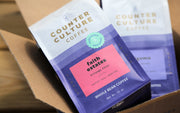Making good coffee can come down to some pretty fine details, including the size of the ground coffee particles, the temperature of your water, and the way you brew the coffee. In this post, we will focus on one variable—the coffee-to-water ratio and walk through the optimal ratios for common drip and immersion brew methods.
What Is A Coffee-To-Water Ratio?
The coffee-to-water ratio is the amount of coffee you are using compared to the amount of water you should be using with that amount of coffee. Usually, we will say “1 to x” or “1:x”. The "1" is 1 gram of coffee, and the x is the number of grams of water you should be using.

Why use ratio and not give a recipe, though? A recipe is very straightforward. “Use 30 grams of coffee and pour 500 grams of water.” Well, not everybody wants to make that much coffee, and some people want to make a lot more! If we use a ratio to describe how much coffee you should use compared to water, you can scale your recipe as big or small as you want and still get the same flavor results.
As a broad standard, we recommend a 1:17 ratio.
With a 1:17 ratio, for every 1 gram of coffee, use 17 grams of water. This gives the best chance for an ideal extraction—the process of dissolving soluble flavors from coffee grounds using water—with a complementary strength. This ratio is optimal for manual and automatic pour-over methods. This also happens to be the ratio (rounded) for the recipe mentioned above – 30 grams of coffee and 500 grams of water.

Measuring With Grams
As you may have noticed, we recommend weighing everything in grams. This allows you an appropriate amount of precision to get great results, and by weighing everything, your results are going to be much more consistent. To weigh your coffee, we generally recommend using a basic kitchen scale. Anything that will weigh to the nearest gram is usually good enough. For those who want to be extra precise, high-tech scales like the Acaia Pearl are great. If you plan to get into making excellent espresso, a scale that can measure to the tenth of a gram will be a must.
For those without a scale, using tablespoons and ounces to measure coffee or water, follow the ratio of 1:4. Use 1 tablespoon of coffee for every 4 ounces of water. A scale will be much more precise and your results will be more consistent. This is especially true if you brew more than one kind of coffee at home on a regular basis. But if a scale isn’t an option, tablespoons and ounces will do in a pinch.
Full Immersion Brewing
Full immersion methods require a slight modification from the 1:17 ratio recommended for drip methods. Examples of full immersion brewing include the French press, siphon, and Clever Dripper. These methods require a tighter ratio, closer to 1:15.

Water and coffee sit together much longer in a full immersion brew method than in a drip method like the auto drip or the pour-over. In those methods, fresh water is poured, flows through the grounds, and exits rather quickly. In full immersion methods, all of the water sits with all of the coffee for the full brewing time, and therefore there is more time for extraction to happen in all of the water at once. A little less coffee helps balance out the flavor.
We hope this guide has helped to improve your brewing process and helps create better cups of coffee, and now that you’re ready to make excellent coffee, find the perfect coffee for you!








